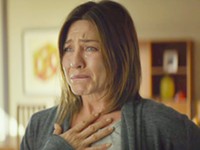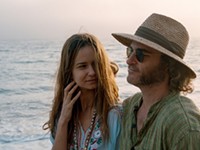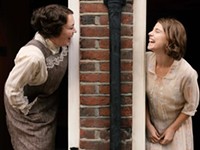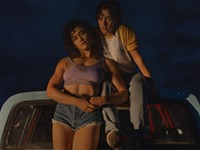[
{
"name": "500x250 Ad",
"insertPoint": "5",
"component": "15667920",
"parentWrapperClass": "",
"requiredCountToDisplay": "1"
}
]
The curious history of The Ring Two provides an appropriate lesson in the globalization of what at one time seemed a largely American approach to film.
The mere fact of the picture's appearance may reassure those students of international cinema who deplore the American habit of repetition and self-imitation, the endless spinning of remakes and sequels that turns films into franchises. The new picture reminds us all that other national film industries also indulge in the practice, apparently believing, with Hollywood, that nothing succeeds like excess.
The movie of course builds on its surprisingly successful predecessor, The Ring, which itself copied a highly profitable Japanese movie, Ringu (funny how much the two languages are alike, huh?), itself based on a series of horror novels popular in Japan. Hideo Nakata directed both Ringu and one of its sequels, imaginatively entitled Ringu 2, and now, in what must have seemed a genuine coup to the producers, directs the American sequel, though whether the movie follows The Ring or copies Ringu 2 remains unclear.
Whatever its origins, however, The Ring Two represents a considerable diminution of just about every quality that gave the original both its power and its profitability. The original (American) movie, which appeared in 2002, generated considerable fright from its unusual combination of a genuinely puzzling mystery and such contemporary horror film elements as the threatened and threatening child, the sexual transgressions of the sliced teenager flick, and the dangerous television of titles as different as Videodrome and Poltergeist. Most important, it created much of its fright from a series of strangely evocative images --- a glowing circle, a ladder leaning against a wall, a face at a window, a woman looking in a mirror --- all transmitted on a grainy videotape that kills anyone who sees it within seven days.
Although Ring Two begins as if it were actually going to proceed further with those materials, the script soon degenerates into something much more ordinary and much less meaningful, a series of shocks and frights that marches along in a surprisingly dull and predictable pattern. Naomi Watts returns as the newspaper reporter Rachel Keller, the single mother of Aidan (David Dorfman), now working in a small seaside city in Oregon and once again haunted, and even stalked, by the fatal videotape.
She visits the scene of a teenager's death, apparently from fright, where she sneaks a peek at his horribly distorted face and later discovers and burns the tape, which somehow keeps turning up anyway, playing on various television screens throughout the movie.
The indestructible tape, its images somehow much less evocative and chilling than in the previous movie, functions mostly as a device to distress Rachel and threaten her son. Most of the time other, mostly inexplicable menaces intervene, especially the constant resurrection of the dead young girl of the first movie, a gaunt, creepy apparition named Samara, who pops up frequently in various backgrounds, reaches out from the television screen, and slithers up out of the bathtub drain. She not only causes the death of a few characters but apparently wants to inhabit the body of young Aidan, who occasionally displays a certain unsettling resemblance to the scary creature.
Most of the menace otherwise resolves itself into a persistent dampness, appropriate to the Northwest, with water flowing everywhere, including on a bathroom ceiling rather than the floor; Samara dwells deep inside the well of the first movie, which apparently survived its earlier destruction, and she tends to flood a number of scenes.
In another strange moment a herd of deer, presumably incited by the supernatural presence or control of the dead girl, attack Rachel and Aidan in her car, one of the weirdest and least convincing assaults in the bloody history of horror.
While most of the cast behaves according to the utilitarian demands of the usual horror film, nobody really transcends the level of mere mediocrity. A bland and boring actor, Naomi Watts adds no particular distinction to the film, which simply demands that she periodically demonstrate fear and then proceed to do exactly the wrong thing.
Unlike the usual cutesy kid actor, David Dorfman looks rather like a little old man, which at least adds a further bit of strangeness to the role of the menaced and potentially menacing child. Finally, Sissy Spacek occupies one scene, playing the dead Samara's mother, and simply chews the scenery in the manner of Lady Macbeth doing the death scene from Camille, perhaps the greatest horror in The Ring Two.
The Ring Two (PG-13), starring Naomi Watts, David Dorfman, Simon Baker, Elizabeth Perkins, Emily VanCamp, Ryan Merriman, Sissy Spacek; screenplay by Ehren Kruger; directed by Hideo Nakata. Cinemark Tinseltown, Loews Webster, Pittsford Plaza Cinema, Regal Culver Ridge, Regal Eastview, Regal Greece Ridge, Regal Henrietta.
Latest in Movie Reviews
More by George Grella
-

Film Review: "Cake"
Jan 26, 2015 -

Film Review: "American Sniper"
Jan 19, 2015 -

Film Review: "Inherent Vice"
Jan 12, 2015 - More »






